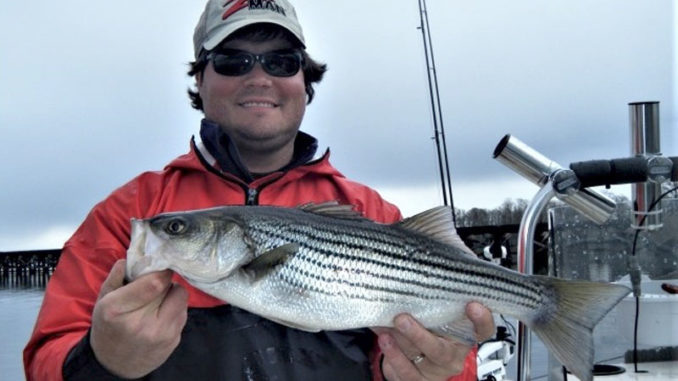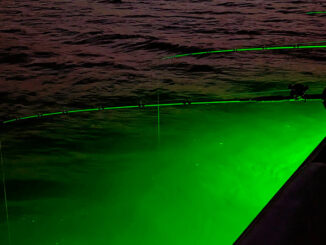
The presence of birds often means good striper fishing
Guide Richard Andrews of Bath, N.C., is a bird-watcher in January on the Albemarle Sound.
Not normally mesmerized by birds, he looks for hovering and diving gulls and terns when winter arrives.
“A lot of times, you’ll find stripers underneath birds,” said Andrews, of Tar-Pam Guide Service (252-945-9715).
Striped bass — or “rockfish” east of I-95 — have voracious appetites. After their strength-sapping, spring spawning migration up the Roanoke River, resident fish return to the sound where they remain, feeding on gigantic schools of menhaden.
“Stripers suspend under congregated baitfish schools and often push them to the surface,” said Andrews, in his 11th year as a guide. “Look for birds circling and diving or sitting on the surface picking. Sometimes you see stripers busting baits on the surface.
“I’ll cast soft-plastic lures — Flukes, 5-inch jerkbaits or 3- or 4-inch swimbaits — at ’em.”
Andrews will fish 3/8- or 1/2-ounce jigheads with white or chartreuse Z-Man lures for trailers.
“I also look for striper schools with my adjustable side-imaging radar that picks up fish from 80 to 100 feet to the sides of my (boat),” he said. “The side-imager’s zoom function can reach out to 400 or 500 feet. But that’s too far. It won’t give you a good idea of what’s out there.”
Andrews prefers 7-foot, medium-light spinning rods with 2500 series reels spooled with 15- to 20-pound braid. He doesn’t charge into schools of birds or stripers once he locates them.
Don’t disturb the birds!
“You want to slow down to idle,” he said. “You don’t want to bust up the birds. You want them to stay over the fish. But if birds disperse, a lot of times stripers still will be there.”
After finding a school, Andrews casts swimbaits and lets them drop slowly to the bottom before using a steady retrieve. If he’s using Flukes or jerkbaits, he lets them sink, then retrieves them by popping his rod tip a couple of feet and letting them fall.
“During cold weather, stripers stay on the bottom,” he said. “They like to hit falling lures. But if they suspend in the water column, you can crank a little faster to run lures through them or rip jerkbaits up in the water column then let them fall.”
If birds aren’t flying or the striper are scattered, Andrews will throw the same lures at structures such as bridges or deep stump fields off points or offshore from certain shorelines.
The sound’s bottom can range from 12 to 20 feet deep.
“Fish get shallower when days are warmer,” he said. “Sometimes stumps extend into 10 feet of water, and stripers will orient over them. I’ll run lures right over the top of stumps,” said Andrews, whose fishing area extends from the mouth of the Roanoke River east and south into the Alligator River.
In the Albemarle Sound Management Area, anglers can keep two fish per day longer than 18 inches from Oct.1-Dec. 31, 2020.
“A really good day, you might catch and release 100 to 200 fish,” Andrews said. “An average day should be 50 to 100 fish.”





Be the first to comment